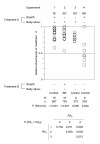Allomonal effect of breath contributes to differential attractiveness of humans to the African malaria vector Anopheles gambiae
- PMID: 14748930
- PMCID: PMC343289
- DOI: 10.1186/1475-2875-3-1
Allomonal effect of breath contributes to differential attractiveness of humans to the African malaria vector Anopheles gambiae
Abstract
BACKGROUND: Removal of exhaled air from total body emanations or artificially standardising carbon dioxide (CO2) outputs has previously been shown to eliminate differential attractiveness of humans to certain blackfly (Simuliidae) and mosquito (Culicidae) species. Whether or not breath contributes to between-person differences in relative attractiveness to the highly anthropophilic malaria vector Anopheles gambiae sensu stricto remains unknown and was the focus of the present study. METHODS: The contribution to and possible interaction of breath (BR) and body odours (BO) in the attraction of An. gambiae s.s. to humans was investigated by conducting dual choice tests using a recently developed olfactometer. Either one or two human subjects were used as bait. The single person experiments compared the attractiveness of a person's BR versus that person's BO or a control (empty tent with no odour). His BO and total emanations (TE = BR+BO) were also compared with a control. The two-person experiments compared the relative attractiveness of their TE, BO or BR, and the TE of each person against the BO of the other. RESULTS: Experiments with one human subject (P1) as bait found that his BO and TE collected more mosquitoes than the control (P = 0.005 and P < 0.001, respectively), as did his BO and the control versus his BR (P < 0.001 and P = 0.034, respectively). The TE of P1 attracted more mosquitoes than that of another person designated P8 (P < 0.021), whereas the BR of P8 attracted more mosquitoes than the BR of P1 (P = 0.001). The attractiveness of the BO of P1 versus the BO of P8 did not differ (P = 0.346). The BO from either individual was consistently more attractive than the TE from the other (P < 0.001). CONCLUSIONS: We demonstrated for the first time that human breath, although known to contain semiochemicals that elicit behavioural and/or electrophysiological responses (CO2, ammonia, fatty acids) in An. gambiae also contains one or more constituents with allomonal (~repellent) properties, which inhibit attraction and may serve as an important contributor to between-person differences in the relative attractiveness of humans to this important malaria vector.
Figures



References
-
- Takken W. The role of olfaction in host-seeking of mosquitoes: a review. Insect Sci Appl. 1991;12:287–291.
-
- Hamilton JGC, Ramsoondar TMC. Attraction of Lutzomyia longipalpis to human skin odours. Med Vet Entomol. 1994;8:375–380. - PubMed
Grants and funding
LinkOut - more resources
Full Text Sources
Other Literature Sources

